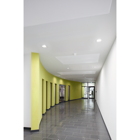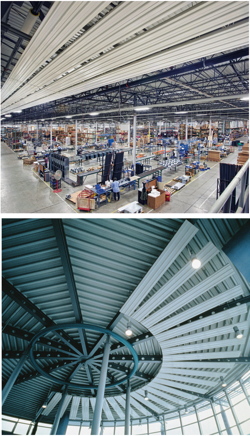Taking heating efficiency and comfort to new heights

Radiant heating panels are growing in popularity, and for a number of good reasons. David Simoes of Zehnder Group UK explains where they are appropriate and what benefits can be expected.
Q: What does radiant heating look like in commercial premises and what kinds of premises is it suited to?
There is more to ceiling-mounted radiant heating panels than meets the eye. In many applications, the panels are incorporated so unobtrusively within the fabric of the building that occupiers are unaware of their presence. Equally, however, radiant panels and sails can also be free-hanging and designed to make a great-looking style statement. At Zehnder we offer a multitude of different sizes, shapes and colours. Some options can also, if required, incorporate lighting, sensors, and other services.
In the past, radiant panels were typically used to heat large spaces such as sports halls and industrial units, but now they are also found in many much smaller premises such as schools, offices, retail and healthcare environments.
With careful design, radiant panels can be fitted in rooms with low ceilings (they require only a short space under the structural ceiling) as well as rooms with heights as great as 20 or even 30 m. Because panels at height are unlikely to be touched, it is possible to safely increase water temperature to achieve a higher surface temperature (up to 85°C) and greater output from the heating surface area as long as the temperature/coverage balance is managed.
Q: What are the benefits over other kinds of heating — including comfort, energy efficiency and maintenance?
The great advantage of radiant heating is that it works by transferring heat by infra-red radiation. Convection heating is different because it first has to heat the air, which in turn heats objects in contact with the air.
This means radiant heating will heat only the solid objects in a space, such as furniture and people.
Radiant heating will also only radiate in the direction in which its source is pointed, so that the panels heat only the solid objects in their ‘line of sight’. Panels can be positioned to eliminate the heating of outside walls and ceilings, which other types of heating warm-up needlessly at the cost of wasteful energy consumption. For these reasons radiant heating can create comfort more effectively and more efficiently than heating the large volumes of air in the room space.
Radiators, unlike radiant heating, don’t have this efficiency because — despite their misleading name — they actually deliver only 20% of their heat through radiation and 80% through convection.

The effectiveness of radiant heating can be measured by the mean radiant temperature (MRT) of the space, which is the average of all temperatures of all surfaces and people in a room. If room air temperature was 18°C, with radiant heating panels occupants could typically feel as if it was 21⁰C, so room temperatures do not have to be as high as with other systems.
When using warm air to heat a space, air would normally be added at a temperature of 10 to 15 K above the ambient temperature. This is not necessary with radiant heating. It should be no surprise, then, that heating air can be as much as 25% more expensive using water as the medium to transport heat to a radiant system.
Another advantage of radiant heating panels is that they allow for best use of available floor space because they are installed within the fabric of the building.
Radiant heating’s health benefits are further enhanced because dust and other pollutants such as mould, fungi, bacteria and viruses are not circulated by the constant air movement associated with conventional convection systems. This is important; independent research shows that indoor air quality (IAQ) has significant effects on worker health, absenteeism, and cognitive performance. For these reasons, IAQ is moving up the agendas of those running office buildings, which will further boost the appeal of radiant heating.
Lower maintenance costs are another advantage. With their ability to provide heating or cooling, radiant panels can eliminate the need for air conditioning through traditional ducted systems and fan-coil units. Radiant panels require no maintenance for moving parts or filtration, and there’s no need for management of draughts or condensate.
As awareness of these benefits grows, so too does radiant heating’s popularity. At Zehnder we also expect the take-up of radiant heating to increase in line with the adoption of newer and cleaner energy technologies, because radiant heating and cooling panels are adaptable for use with solar panels and heat pumps. It is more than a century since radiant-heating technology was invented, but at last its day has come.
David Simoes is marketing manager for specification at Zehnder Group UK.







